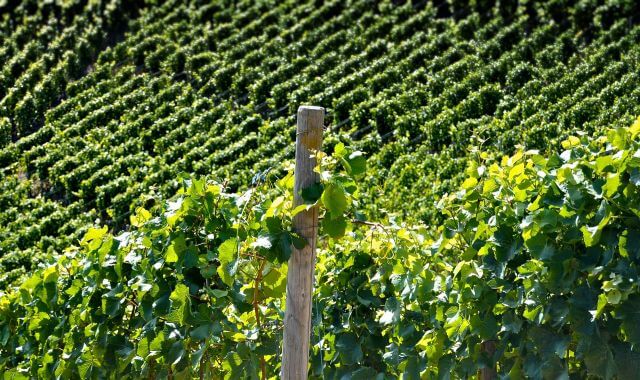Come harvest season, wine makers have grown accustomed to looking for the telltale signs of a common but devastating threat: black mold and spores combined with a distinct acidic smell. These symptoms are associated with grape sour rot disease, an incurable condition involving the decomposition of damaged berries that ultimately degrades wine quality, resulting in millions of dollars in losses annually.
New research led by Tufts University shows that the invasive European paper wasp, Polistes dominulus, plays a role in facilitating sour rot disease in the absence of other insects.
Published today in PeerJ, the study sought to expand the knowledge of the ecology of this disease, which is characterized by acetic acid bacteria, Ascomycota yeasts, and filamentous fungi that attack ripe, thin-skinned berries mostly in late summer.
“The research showed that these wasps carry the polymicrobial community of sour rot and are capable of dispersing live microorganisms when foraging,” said Anne Madden, Ph.D., first author of the study and a graduate of the Department of Biology in the School of Arts and Sciences at Tufts University. Madden is currently affiliated with Keck Center for Behavioral Biology at North Carolina State University, Raleigh, NC, and is also a postdoctoral researcher in the Department of Applied Ecology at North Carolina State. “This suggests that wasps are playing a role, which had not been previously identified, and may help shed light on more effective management strategies or treatments to curtail these annual losses.”
Wasps are naturally present in vineyards, and in late summer they primarily forage on sugar-rich foods like ripe grapes. To determine the role wasps were playing in spreading sour rot disease, researchers conducted two sets of experiments: one in which wasps were inoculated with microorganisms associated with sour rot, and another in which the wasps were not inoculated with any microorganisms.
In order to replicate natural berry splitting, a phenomenon that occurs in vineyards due to water pressure imbalances in berries after heavy rains or if the berries have been densely packed, half the grapes used were aseptically “injured.”
The inoculated and unninculated wasps were allowed to forage in enclosures featuring both injured and intact grapes for a 13-day period. The grapes were then removed and assessed based on a metric system designed to measure disease incidence and decomposition severity.
Researchers focused on the presence of black spores; acetic concentration; and black mold incidence. Using the Mann-Whitney U test, researchers statistically compared black mold incidence and berry decomposition scores of uninjured grapes with and without wasps.
Among the key findings:
- There was no impact of wasps on uninjured grapes
- The foraging of inoculated wasps increased the incidence of filamentous fungi, black mold on injured grapes, and the severity of disease in injured grapes
- The foraging of uninoculated wasps increased the severity of disease and the average concentration of acetic acid in grapes.
Sour rot disease microbial complex includes yeasts, filamentous fungi and acetic acid bacteria, but the acetic acid bacteria are responsible for the worst of the disease symptoms. All inoculated wasps were found to harbor acetic acid bacteria.
More than half (52 percent) of the wasp carried sour rot associated yeasts. Eighty-eight percent of the wasps tested harbored at least one of five different kinds of saprotrophic filamentous fungi. In all, half the wasps contained the full complement of sour rot microorganisms.
Madden noted that there was significant variability in the presence of microorganisms. In some wasps, the bacterial community was dominated by acetic acid bacteria, while in others it was barely detectable.
“This variability suggests that rather than being automatically associated with wasps, these microorganisms may be acquired from the local environment,” said Madden
Additional authors are Sean D. Boyden, undergraduate student in the Department of Biology at Tufts University; Jonathan-Andrew N. Soriano, graduate of the Department of Biology at Tufts University and current staff scientist at Cue Biopharma of Cambridge, MA; Tyler B. Corey, graduate of the Department of Biology at Tufts University and current Ph.D. candidate in the School of Biological Sciences at the University of Nebraska, Lincoln, NE; Jonathan W. Leff, Ph.D. candidate in the Department of Ecology and Evolutionary Biology at the University of Colorado at Boulder, Boulder CO; Noah Fierer, associate professor, Department of Ecology and Evolutionary Biology at the University of Colorado at Boulder; and Philip T. B. Starks, associate professor, Department of Biology at Tufts University.
This study was funded by the National Science Foundation (NSF) Graduate Research Fellowships Program, Tufts Institute of the Environment Fellowship, Wellesley College Graduate School Fellowship, Lewis and Clark Fellowship from the American Philosophical Society, Theodore Roosevelt Memorial Grant from the American Museum of Natural History, and the Tufts Graduate Student Research Awards. Additional funding was provided by the Tufts University Summer Scholars Program. The funders had no role in the study design, date collection and analysis, decision to publish, or preparation for the manuscript.
Madden et al. (April 2017) “The emerging contribution of the social wasps to grape rot disease ecology”


